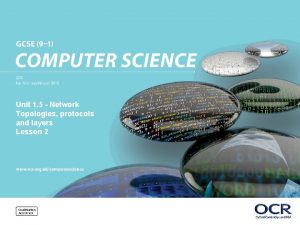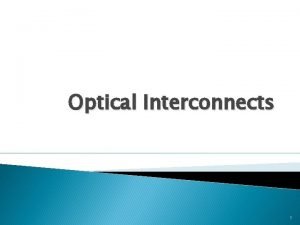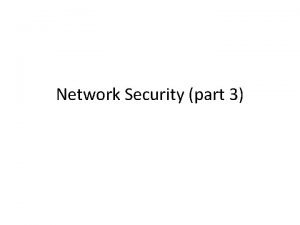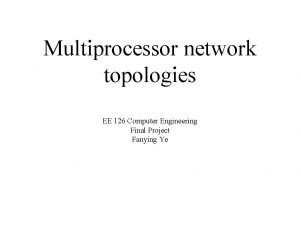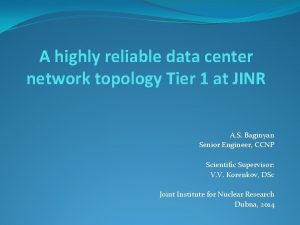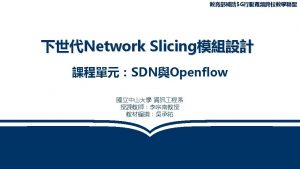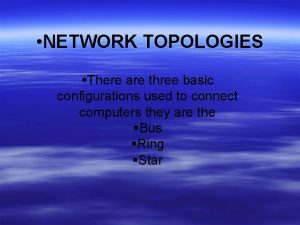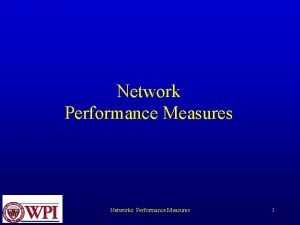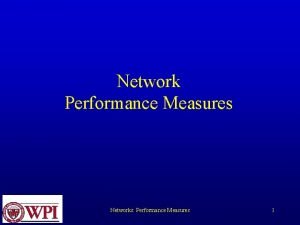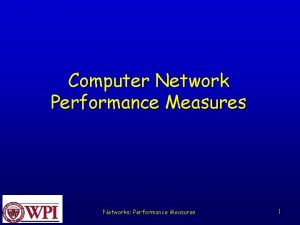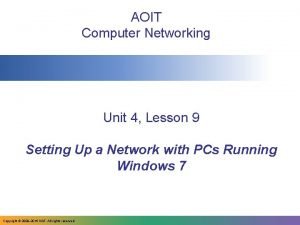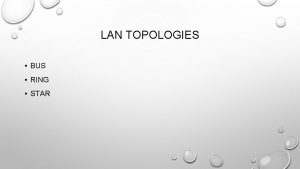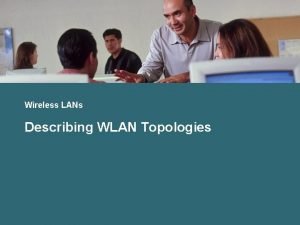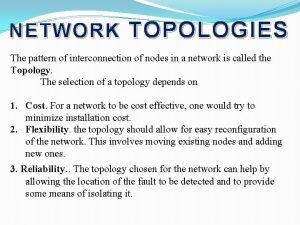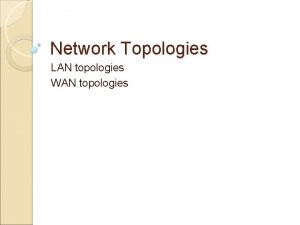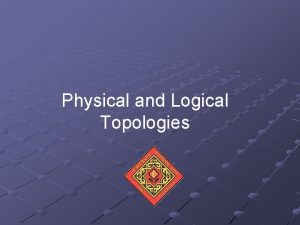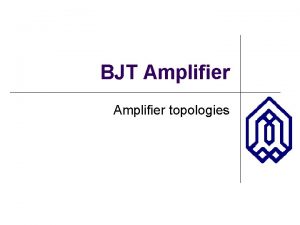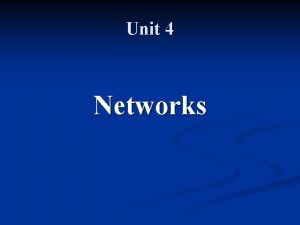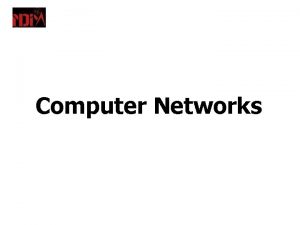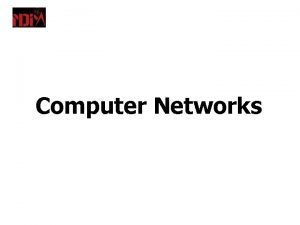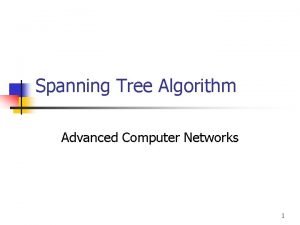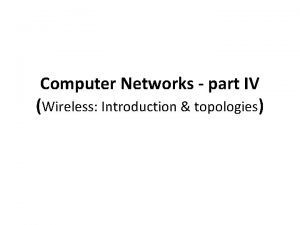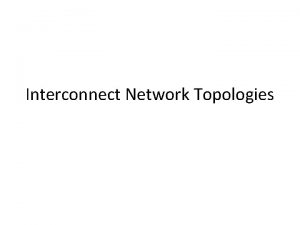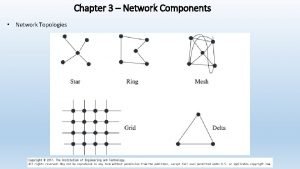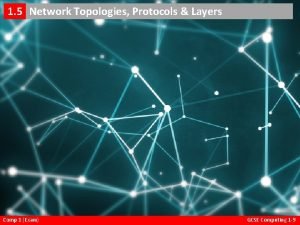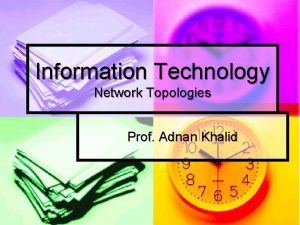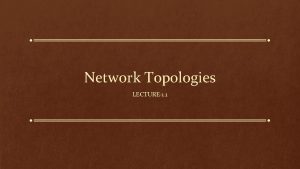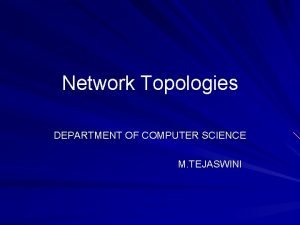Unit 9 Computer Networks Topologies and Network Models























- Slides: 23

Unit 9: Computer Networks Topologies and Network Models

Defining Components of the Network Home Office Mobile Users Internet Branch Office Main Office

Defining Components of the Network (cont. ) Branch Office Floor 2 Server Farm ISDN Floor 1 Telecommuter Remote Campus

Network Topologies LAN • Physical Star • Physical Bus • Logical Bus (Hub and Spoke) Hub • Logical Star • Physical Star (Hub and Spoke) Switch • Logical Bus

Network Topologies LAN Full Mesh Partial Mesh

Network Topologies WAN Server 1 R 2 Larry R 1 Physical Star R 3 Logical Full Mesh Bob Server 1 R 2 Larry R 1 Physical Star Logical Partial Mesh R 3 Bob

Network Topologies LAN/WAN Physical Single Ring Logical Ring Token ring hub Physical Dual Ring Logical Ring Physical Star Logical Ring

Physical Topology types Physical topology types Function Description Bus This is a linear topology, with all devices connected to the cable Star Each device is connected to a central point, sometimes called hub-and-spoke Extended Star A star topology is in the centre, but instead of each point being a single device, it can be the centre of another star topology Full Mesh Each device has a direct connection to each other device Partial Mesh Each device does not have a direct connection to each other device Single Ring Each device is connected directly to two others so that the signal is repeated in one direction, creating a ring or loop Dual Ring . Two rings go through the same set of devices, allowing loops to be made upon failure, which continues the operation of a ring

OSI Model

Why a Layered Network Model? • Reduces complexity • Standardizes interfaces • Facilitates modular engineering • Ensures interoperable technology • Accelerates evolution

The Seven Layers of the OSI Model Examples Telnet - FTP

The Seven Layers of the OSI Model Examples Telnet - FTP ASCII - EBCDIC JPEG

The Seven Layers of the OSI Model Examples Telnet - FTP ASCII - EBCDIC JPEG Application Access Scheduling

The Seven Layers of the OSI Model Examples Telnet - FTP ASCII - EBCDIC JPEG Application Access Scheduling TCP – UDP - SPX

The Seven Layers of the OSI Model Examples Telnet - FTP ASCII - EBCDIC JPEG Application Access Scheduling TCP – UDP - SPX IP - IPX

The Seven Layers of the OSI Model Examples Telnet - FTP ASCII - EBCDIC JPEG Application Access Scheduling TCP – UDP - SPX IP - IPX 802. 3/802. 2 - HDLC

The Seven Layers of the OSI Model Examples Telnet - FTP ASCII - EBCDIC JPEG Application Access Scheduling TCP – UDP - SPX IP - IPX 802. 3/802. 2 - HDLC EIA/TIA-232 - V. 35

Data Encapsulation

Data De-Encapsulation

Peer-to-Peer Communication

TCP/IP Stack • Defines four layers • Uses different names for Layers 1 through 3 • Combines Layers 5 through 7 into single application layer work

TCP/IP Stack versus the OSI Model

END
 Vc vs datagram
Vc vs datagram What are the 5 network topologies?
What are the 5 network topologies? Network topologies and layout
Network topologies and layout Basestore iptv
Basestore iptv Ppt on network topology free download
Ppt on network topology free download Network security topologies
Network security topologies Ee 126
Ee 126 Data center network topologies
Data center network topologies Three-tier network topologies
Three-tier network topologies Network physical topologies
Network physical topologies Network topologies
Network topologies Three basic network topologies
Three basic network topologies Principles of network applications
Principles of network applications Design issues of network layer
Design issues of network layer Network layer design issues in computer networks
Network layer design issues in computer networks Network performance measurement in computer networks
Network performance measurement in computer networks Network performance measures
Network performance measures Router node
Router node Unit 4 computer networks
Unit 4 computer networks Bus, ring and star topologies mostly used in the
Bus, ring and star topologies mostly used in the Semimodals
Semimodals Wlan lan
Wlan lan Use a common backbone to connect all devices
Use a common backbone to connect all devices The advantages of bus topology
The advantages of bus topology

